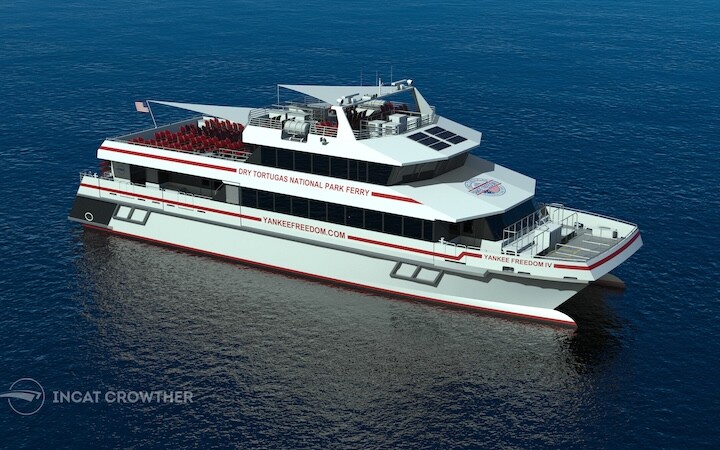Key West, Fla.-based Yankee Freedom has awarded a contract to Gladding-Hearn Shipbuilding, Duclos Corp. to build a 300-passenger, high-speed catamaran.
The new cat will provide passenger service between Key West and the Dry Tortugas National Park. The new vessel will replace Yankee Freedom III, a 250-passenger catamaran built for the 70-mile run by the Massachusetts-based shipyard in 2012. Delivery of Yankee Freedom IV is planned for 2026.
The new larger vessel, designed by Incat Crowther, retains the strong brand presence Yankee Freedom has established with tourists to the national park, said company officials.
The 112.5'x31.6' all-aluminum catamaran will draw 6.9'. It will be powered by a pair of MTU 12V-4000M65R EPA Tier 4-compliant diesel engines, each delivering 2,000 hp at 1,600 rpm and turning nibral propellers. The twin gearboxes will be ZF 8000s. The ferry will be equipped with an Atlantic Detroit Diesel-Allison 80-kW EPA Tier 3 genset with the addition of exhaust gas treatment. A Humphree active interceptor ride control system will be installed to control vessel pitch and roll. Top speed will be over 28 knots, with a deadweight of 29.5 tonnes.
Accommodations in the main cabin include seating for 130 passengers, tables, a snack bar and an audio/visual passenger information center. Aft of the bar is a storage room. On the aft deck will be an open covered area with four passenger heads, a shower area and stowage for kayaks and camping gear. A two-level platform and handrails will be installed on the open bow deck for passenger viewing.
The second deck includes the pilothouse forward, followed by an enclosed cabin with seating and tables for 60 passengers, and exterior seating for 72 passengers aft. Additional outside seating for 40 passengers will be located on the third deck. A 180,000-Btu HVAC system heats and cools the cabins and pilothouse.
The new ferry will include many of the environmental features required by the National Park Service, such as zero discharge of black and grey waste-water, energy-efficient LED lighting, heavy metal-free bottom paint, and zero-VOC vinyl marine film instead of paint on the exterior. Multiple solar panels, mounted on the roof, will produce 24-volt D/C electricity stored in batteries and converted to power the vessel’s running lights and the pilothouse’s electronics.




